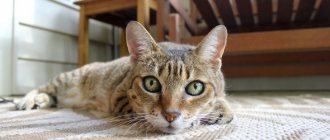| Origin: | England |
| Usage: | gun dog for bird hunting |
| Color: | black, orange, lemon and brown speckled or speckled (black or brown) and tan |
| Dimensions: | 65 – 68 cm and 27 – 30 kg males, 61 – 65 cm and 25.5 – 28 kg females |
| Lifespan: | up to 15 years, average – 11 years |
The English Setter is an amazing breed.
She combines playfulness and aristocratic manners, immense love for people and the passion of a hunter, childish mischief and devotion, elegant appearance and tirelessness. Setters are wonderful companions. Many people start them. But it should be remembered that dogs love hunting no less than people. Just games and walks are not enough for them.
Appearance and standard
The FCI approved the English Setter breed standard in 2009. He describes the dog as hardy, passionate, lean, with well-developed muscles. The dog is friendly and non-aggressive towards people and animals.
| Parameter | English Setter Standard |
| Frame | Elongated, strong. The back is straight, the chest is deep, the ribs are convex, the neck is long. The stomach is slightly tucked. |
| Head | Oval in shape, the back of the head and eyebrows are pronounced. |
| Bite | Scissor-shaped, complete dentition. |
| Ears | Hanging, medium length, thin, round. Stand at eye level or slightly lower. Covered with 5–8 cm of fur. |
| Eyes | Large, evenly spaced. Brown, preferably dark shades. Eyelids to match the suit. The expression is kind and intelligent. |
| Nose | Black or brown, fully pigmented. |
| Limbs | Long, evenly set, parallel, with prominent muscles. Elbows clasp the body and look back. |
| Paws | In a ball, oval, straight hair grows between the toes. |
| Tail | Set below the line of the back, saber-shaped or straight, tapering towards the end. In an excited state, the dog lifts it up to its back and waves cheerfully when walking. |
| Wool | Thick, silky, long and straight. Feathers on the ears, limbs, lower chest and tail, “pants” on the hips, feathers on the tail. |
| Color | Pure white and steel with small spots on the legs; white with blue, black, liver, orange, lemon specks; white with black or orange spots or specks and tan. |
An English Setter dog during a hunt is an incomparable spectacle. She walks at a creeping gallop, the so-called. shuttle When it smells prey, it takes a cat-like step. Approaching the bird, it freezes and makes a stance - lying or standing.
English Setter Care
An area of special attention when caring for an English Setter is the dog's long ears. They fit tightly to the head, so they need to be cleaned regularly. This way you will prevent the accumulation of sulfur and the development of otitis media. Brush your dog regularly and then wipe it with a damp towel - then you won’t have to bathe your setter. However, dogs participating in exhibitions will still need a bath to give their coat a shiny, well-groomed appearance.
The setter's ears are regularly wiped with a damp swab and checked for ticks. Ear mites and accumulated wax can cause otitis media. The dog's eyes are wiped with a swab moistened with strongly brewed tea. The animal's teeth are cleaned with a special toothbrush placed on a finger. To clean your teeth, you can purchase special-purpose bones.
The paws of the English Setter require special attention. To prevent the wool on them from getting dirty, it is carefully cut off, freeing the pads. The claws are trimmed and sharpened. To prevent cracking of the skin on the pads, they are lubricated with rich cream or vegetable oil.
In the house, the English Setter needs to allocate a corner away from drafts and provide him with a soft bed. A children's orthopedic mattress is suitable.
Features of the coat of setters include shedding. Thus, the soft, silky hair of the puppy period is shed unevenly: the hair along the spine changes first, and then on the sides. When the dog reaches 12 months, the coat takes on its complete appearance.
Before a year, it is not necessary to carry out any wool treatment, except for general hygiene. To care for hair during this period you will need: a dog mitt, a brush with stiff bristles and combs that have round teeth in cross-section - rare and frequent, scissors, straight hairdressing and thinning tools, as well as lanolin.
The setter's coat should be washed with shampoo rarely, as it gets dirty. Dousing with water often in summer, swimming in open, clean water will only benefit the coat. In the event of a walk in the slush, it is necessary to restore the decorative hair to its proper form, taking into account the benefits of lanolin after washing. Setter paws require routine care. The difficulty is in cutting the paws, which needs to be mastered at the very beginning: check the length of the claws, and if necessary, shorten them. This is convenient to do with scissors: cut the hair between the pads of the toes, in the spaces between the toes; thinning scissors are convenient to use to cut the hair from the top of the paw to the second phalanx, which results in a round, “cat’s” paw.
After walks, the coat is regularly brushed with a bristle brush. Decorating hair should be combed 1-2 times a week. To do this, first use sparse and then frequent combs, carefully ensuring that tangles do not form (often around the elbow, behind the ears and on the stomach). The hair on the head is cut with thinning scissors when required.
We advise you to read: Bichon Frize Dog Breed
The procedures described are sufficient for regular care of a dog for up to a year.
To participate in exterior exhibitions, you need an additional set: stripping comb, knife, clipper, spray varnish with lanolin.
The dog that is exhibited in the ring has a sculpted head with a clearly defined occipital protuberance; the neck is set high, with a smooth, slightly convex arch into the withers, which stand out well above the level of the back; the back is strong, straight; the lower back is somewhat convex and muscular; the croup is wide and slightly sloping; the chest is deep, well developed; The front legs are parallel, the hind legs are straight and muscular with well-developed joints. The coat on the shoulders, neck, sides, outer surfaces of the thighs, and tail is straight, not wavy, and fits tightly.
How to achieve this? Shortly before the exhibition (from two to one and a half weeks, depending on how quickly its coat grows), the dog is washed using a mild neutral shampoo. After which it is recommended to rub in the balm and rinse the coat.
Dry the animal, comb the hair with a mitten in the direction of its growth. When the wool is dry, it is necessary to apply varnish with lanolin evenly over the entire surface of the back, along the spine. In this case, the varnish should not get on the ears, neck, head and paws. If necessary, treat the paws as described above. Special attention should be paid to the neck, shoulders, sides and outer surfaces of the hips and tail - hair that puffs up or curls into rings, lies in waves, or is plucked using the placking technique.
The lower adjacent surface of the base of the tail, as well as the anus area, is cut short with a clipper. Thick decorative hair should fall vertically to the hock joint. The hair on the back surface of the metatarsus is shortened when the hock joints are well developed. The preparation of the ears is as follows: a third of their length from the base, it is necessary to partially free them from the fringe. It is convenient to do this with an electric machine, avoiding obvious differences in hair length. The throat between the line that connects the corners of the lips with a place five centimeters above the pit on the sternum is cut with a machine in the direction of hair growth or plucked with a stripping knife so that the remaining hair, lying tightly, barely hides the dog’s skin.
Before the exhibition, it is recommended to wash the dog completely or bring its coat into good condition.
Character traits
“There is no dog better than an English setter” – this is the description given by the owners’ reviews. The pet really has an angelic character. There is not a drop of malice in him, he is a selflessly loving animal and a courteous owner. He “receives” guests with people, talks with them, and is not averse to jumping into a stranger’s arms and licking him.
The dog is attached to his family and owner. It is not recommended to leave him alone for more than a couple of 2 - 3 hours: the pet begins to worry and falls into frustration.
English setters are sociable. They follow their owner's heels and participate in household chores. At the same time, pets understand when a person is tired, angry or not in the mood - at such moments they are not intrusive.
Dogs are not touchy. But you cannot treat them cruelly - the animals will become restless, intimidated, and aggression may appear against a background of fear.
Relationships with animals and children
The breed was bred to prevent aggression and dominance. Therefore, dogs do not have conflicts. There are no clashes even between male dogs.
Setters love to play with other dogs. They are not averse to frolicking with cats: these pets get along well with each other.
But communication with domestic rodents and birds is difficult. The English cops consider them prey. They will not kill the animals, but will follow throughout the house and make stands.
True, English setters get used to “their” rabbits and parrots after a while and stop chasing “game” from corner to corner. But street and foreign rodents and birds are considered legal prey.
There is no better friend for children than an English setter. Two irrepressible robbers become an excellent tandem for mischief and pranks. The dog will never bite or even bare its teeth at the baby. But a baby under 6–9 years old should not be left alone with a pet: the first one can injure the dog, and the second one can accidentally push the child.
Upbringing
English setters are dogs of one owner. From the first day the puppy is in the house, one person should take care and feed it.
Setters almost never do any harm. Chewed furniture, torn curtains and uprooted flowers - this is not about them. But they need clear rules - if dogs are not allowed to do something, then forever - and vice versa.
Pets are obedient and easy to train. But they are often distracted by sounds and smells. Some animals are stubborn and may not follow commands.
Training is presented in the form of a game or imitation of hunting. No rudeness, monotonous repetition of commands or strict demands. Only affection and encouragement. And for punishment, a strict tone is enough.
The description of the breed says that English pointers consider themselves friends of man, and behave on an equal footing with their owner. They are more likely to respond to the phrase “Come here” than to the command “Come to me.”
Training and education
From the first days, accustom your pet to a place and cleanliness. Even a teenager can raise smart and quick-witted setters. These dogs are great intellectuals and, trying in every possible way to please their owners, easily perceive and remember everything that is required of them. But they must understand why they need to do this.
Therefore, do not skimp on praise, affection and tasty encouragement. Setters can be a bit stubborn. And also, they are often distracted from the learning process by certain factors that awaken the hunters in them. Proper training can protect your pet from unpleasant situations associated with cars and picking up food on the street.
Application
Initially, the animals were used as gun dogs. But today they are more often taken as companions.
If you need a friend, not a hunter, you should take a show line dog. She doesn't need to run for 12 hours to burn off energy. She is calmer, looks more beautiful, and can sublimate hunting with stances on pigeons and other urban birds.
If you want to hunt game, then you need to buy a dog from hunter breeders. They raise excellent working dogs.
Due to the lack of aggression, there are no watchmen or guards from pets. They would rather kiss a robber than bark at him.
Features of maintenance and care
The photo of the English Setter is worthy of the cover of fashion magazines. But beauty takes time and money. You need to take care of your dog every day and for more than one hour.
Grooming
Cosmetic procedures take a lot of time and effort. Need to:
- Brush your English Setter every day with a long-toothed natural bristle comb and a massage brush - the long hair gets tangled, dirty, and tangled;
- inspect and clean your ears every day - they are long, mites settle in them and dirt gets clogged, without care otitis media develops;
- Brush your teeth 2 – 3 times a week;
- Trim nails once every one to two weeks;
- cut your dog's hair at a pet salon once every 1-1.5 months;
- Once a day, examine your eyes and wipe them from nitrous oxides.
Bathing
The setter needs to be washed every 10-14 days. The owner's arsenal should include:
- liquid shampoo for long-haired dogs prone to allergies;
- dry shampoo - if the dog rolls around in the mud before the next bath day;
- conditioner - apply it after swimming and wash off after 10 minutes;
- balm or rinse for wool.
Some owners do not recommend washing the English Setter more than once every 2 months.
Walk
English Setters are attracted to active people. Forays into nature, long walks in the park and groves are urgently needed for your pet.
The setter is tireless. He can run for hours and not even get out of breath. Therefore, you need to walk with your pet at least twice a day for 1 – 1.5 hours.
Show dogs are not as active as working dogs. The maintenance is simple - a spacious apartment and walking for 2 - 3 hours a day is enough. But working animals need a country home.
These pets do not tolerate heat and cold well. In the summer they make sure that the dogs do not overheat, and in the late autumn and winter they are dressed in waterproof overalls.
Feeding
The only thing there is no problem with is food. English Setters are unpretentious and eat whatever is offered. But their main advantage is a sense of proportion.
There is no need to focus on feeding standards. Dogs are not gluttons and determine their own portion sizes. If the pet does not eat the food in one “lick,” the amount of food is reduced. If he quickly swallows and licks the bowl for a long time, it means there is not enough food and you need to put more.
You can feed your pet ready-made dry or wet food or natural food. He needs a balanced diet based on lean meat with the addition of cereals, dairy products, vegetables, eggs, vegetable oils and fruits.
Character of the English Setter
The English Setter is one of the most polite, balanced, and truly intelligent breeds. Setters are affectionate, kind dogs, devoted to their owners. They are sociable, love children, and enjoy playing with them. All commands are remembered after several training sessions, and everything is done with pleasure. But the best results can be achieved by changing activities, otherwise the setter will quickly become bored. Stubbornness is common.
The breed has an unsurpassed sense of smell. He is durable, agile and very fast. All these qualities will manifest themselves if the dog constantly feels the attention and love of its owner.
The question of the dog's owner must be resolved immediately when purchasing a puppy. One person must feed, raise and care for the puppy.
The grace and elegance of appearance, calm and delicate disposition of English setters have won love in the hearts of people. Particularly noteworthy is the amazing ability of these dogs to play with children.
The English Setter is an excellent hunter who has tireless energy, agility, endurance and a keen sense of smell. When hunting, it is characterized by a creeping gallop, smooth cat-like movements and peculiar stances that clearly make it clear to the hunter about the location of the prey. At home, the English Setter is affectionate and sociable. Children, for this breed, are the best friends in whom they dote. You can easily travel with English Setters, as they simply love to ride in cars and spend long periods of time with their owners. These dogs almost never bark and are suitable for keeping both in an apartment and in a country house, which makes them excellent family dogs.
English Setters do not tolerate loneliness, so they are not suitable for busy people. If you have your own plot, then be prepared for the fact that your English Setter will dig your ground. The long, thick coat needs to be combed and brushed regularly (especially after hunting) so that it does not form tangles and is smooth and silky.
We advise you to read: Dog Breed English Mastiff
The English Setter gets along very well with children, who can even exhibit them at professional shows.
Developed sense of smell, endurance, quick gallop and an unusually impressive stance are the traits of a born hunter. Once you become the owner of an English Setter, you can hunt with him or simply enjoy the company of a smart and intelligent dog - depending on your preferences and lifestyle.
Interestingly, experts note that the breed has excellent acting abilities. Perhaps this is why the English setter plays the main “dog” role in the film “White Beam - Black Ear,” although the film was based on a book written about the life of a Scottish setter of an unusual color.
Spectacular color, harmonious build, developed intelligence and easy-going character make the English Setter a wonderful companion and an excellent hunter. However, hunting skills require development and strengthening, training with a specialist and time. If hunting is not one of your hobbies, remember that the dog needs long active walks (at least an hour a day) as well as constant communication with the owner. No matter how attractive this breed may seem to you, think about whether you can devote enough time to your pet, will he be left to his own devices?
Do activities and communication with your dog bring you joy and don’t seem like a tedious “obligation”? Amazing! English setters get along easily with other pets, are not prone to loud barking for no reason, and are neat and clean. Who your dog will become - just a family member, affectionate and friendly, or a faithful comrade, an indispensable hunting assistant - depends only on you!
Health
English Setters are a strong breed. They live up to 15 years. But due to numerous and uncontrolled breeding, hereditary diseases occur in pets. Such pets die at 9-11 years of age.
Diseases
Setters are susceptible to:
- pyometra;
- joint dysplasia;
- bone cancer;
- paresis and paralysis;
- allergies;
- volvulus;
- deafness;
- otitis media;
- vision problems;
- dermatitis;
- epilepsy.
Pets get cold easily, so owners make sure that they are not in a draft.
Vaccinations
Viral diseases are a rare situation, because English cops have strong immunity. But they, like all dogs, must be vaccinated against rabies, distemper, parainfluenza and other dangerous infections. Which ones are determined by the veterinarian depending on the epidemiological situation in the area.
History of the origin of the breed
Breeders are still engaged in lively discussions about who is the progenitor of the breed. According to one version, setters descended from spaniels, according to another - from one of the breeds common in Spain. Most breeders are inclined to the first option.
In the 15th and 16th centuries, spaniels were popular in Western Europe. The most famous of them were the setting spaniels. They were used by the nobility to hunt birds. The dog sniffed out the game, carefully stalked up to it and took an unusual stance. Seeing his pet, the owner carefully approached the bird and caught it with a net.
Breeders began diligently breeding setters at the end of the 16th century. The main goal of the breeders was to preserve the working qualities of the pet. For this reason, setting spaniels have been crossed with representatives of various breeds that have excellent hunting characteristics. These included: poodles, greyhounds, retrievers, hounds. The resulting specimens were quite varied.
Breeders began to pay attention to the exterior of the breed only at the beginning of the 19th century. At this time, an unusual feature of dogs was discovered. Their color changed depending on the breeding area. In Scotland, black and tan setters predominated, in Ireland - red-piebald and chestnut-red animals, in England - white dogs with small spots of black, brown and red. The division resulted in three main types of setters: English, Scottish and Irish.
Edward Laverack began breeding English setters. He himself was a professional hunter, so he was attracted to this breed. The man bought two representatives of the breed and began breeding. Laverack has been crossing related dogs with each other for 50 years. The result of his labors were elegant and graceful specimens with excellent hunting qualities.
For some time, Lavrek worked on breeding with the Englishman Richard Llewellyn. But in the process of work, they encountered contradictions. Llewellyn wanted to cross Setters with other similar breeds to achieve the greatest number of varieties. Edward was against such experiments. The breeders diverged their paths, creating two varieties of English Setters.
For the first time representatives of English setters were presented at the exhibition in 1859. Thanks to this phenomenon, the popularity of pets began to grow rapidly. Recognition of the breed and maintenance of the pedigree book of English setters began in the 70s of the 19th century.
Mating
Males and females are untied from the age of 2 years. Until this age, they are not fully formed and remain puppies.
The first heat in female dogs occurs at 6, 12 or 14 months. But they start breeding her on the third or fourth heat.
Estrus lasts 20–22 days. The ideal mating period is 11-15 days.
Females bear puppies for up to 65 days. Pregnant bitches increase the caloric intake of their diet and make sure that they do not leak. It is not recommended to wash the expectant mother. Jumping, going up and down stairs, and swimming in bodies of water are also prohibited.
How to choose a kitten
Since English Setters are bred by all and sundry, you need to find a trusted kennel. Good breeder:
- answers all questions with pleasure, even stupid ones;
- issues pedigrees and metrics for puppies;
- without fear he shows his parents, their documents and photos of the English setter - graduates of his kennel;
- draws up and signs a notarized agreement on the purchase and sale of a pet;
- does not give up puppies before 2 months;
- does not sell babies without vaccinations and anti-parasitic treatment.
English Setter puppies, like Dalmatians, are born without characteristic spots.
The specks will appear later. When examining the kittens, it is necessary to clarify whether there are babies with congenital pathologies, and whether there were such in previous litters.
A calm, moderately active English Setter puppy is suitable for a family.
How much do puppies cost?
The English Setter is an inexpensive breed.
The average price of a breed-class dog is 20-30 thousand rubles. Show-class English Setter puppies are more expensive – from 45 to 80 thousand rubles. You can get a friend even cheaper if you buy him at a poultry market or secondhand - for 2 - 10 thousand rubles. But there is no need to take that risk. It is better to purchase a pet-class kitten from an official nursery. It costs about 15,000 rubles. The baby may have flaws in appearance, but he is healthy.
In Russia, the following nurseries sell purebred English Setters:
- https://www.english-setter.ru/index.htm – Russian club of the English Setter breed, located in Moscow;
- https://www.kamhunting.ru – breeds working lines of English setters and pointers, located in Moscow Region.
The English Setter is a sensitive and loving friend. It's more than a dog. He will become a full member of the family for 10-15 years.
Frequent illnesses and problems
To avoid problems with the health of setter puppies, it is recommended to take the dogs to the veterinarian. At the age of 2 months, the puppy receives its first vaccination; treatment against parasites and worms is mandatory. Be aware of a serious problem for the breed: parvovirus, which can lead to the death of your pet. Setters are prone to the following diseases:
- hip dysplasia;
- inflammatory process with the release of pus in the uterus of bitches;
- paralysis;
- oncology;
- dilatation of the esophagus;
- deafness (often congenital);
- allergy;
- eversion of the eyelid;
- volvulus;
- retinal atrophy;
- dermatitis;
- otitis;
- epilepsy attacks.
It is important to maintain your pet's immunity to avoid the occurrence of all these diseases.
The English Setter is a wonderful companion, a reliable friend and an excellent hunter. He will gladly support his owner's passion for hunting, swimming, and cycling. He has a submissive and affectionate disposition that will allow him to make friends with all family members. Its beautiful appearance will not leave anyone indifferent - you will definitely fall in love with this elegant and proud dog!
Paul McCartney wrote songs for his dog
Paul McCartney ended the Beatles' song "A Day in the Life" with a "dog whistle" (a signal that humans cannot hear, but dogs can hear perfectly well) in honor of his shepherd, Martha. He also wrote the song “My Dear Martha” in honor of her, which was included in the 1968 White Album.
Dogs' paws sweat
It turns out that dogs sweat too. But while humans sweat through the skin all over their bodies, dogs sweat through their paws. You can verify this by watching your dog on a hot summer day. A characteristic symptom will be a salty odor, reminiscent of popcorn or corn chips.
Dogs can memorize hundreds of words
The average dog is as trainable as a human child and can learn between 200 and 500 words. Moreover, the dog can learn the basics of mathematics, such as learning to count and order numbers in ascending order.











